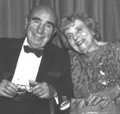

The late Peter and
Sally Sammartino
A Tribute
The following salute to Peter Sammartino is excerpted from a letter by President J. Michael Adams, sent on August 12, 2004, to the University community.
This month marks the 100th anniversary of the birth of an incredible individual. On August 15, 1904, Peter Sammartino was born in New York City. The life he would go on to lead is a moving tale of courage, creativity and conviction.
| “Few men of this modern era could be said to have had more impact on the life of this state, and even the nation, than this man who created Fairleigh Dickinson University…” |
|---|
Peter Sammartino’s legacy is most richly illustrated
by our University.Peter Sammartino’s legacy is most richly illustrated by our University. The decision to form Fairleigh Dickinson was made in 1941; but, in the wake of the bombing of Pearl Harbor, most believed Peter was crazy to proceed. He would not be deterred. Along with his wife, Sally (he once said she did half the work but got none of the credit), he produced one of the great success stories in American higher education.
As Professor Emeritus of English Walter Savage once said, Peter and Sally were “one in deed and dream.” The dream was inspired by Peter’s work at the New College, an experimental school at Columbia University’s Teachers College. Peter, who was chairman of the language department, relished the school’s emphasis on hands-on learning. Students were expected to learn about real life by working in business, about social concerns by working in the community and about global issues by studying abroad — groundbreaking notions at the time. These ideas, combined with a strong liberal arts education, would form the core elements of Fairleigh Dickinson.
Peter especially valued making international connections. Well before it was common, he brought in students, faculty members and visiting lecturers from throughout the world. He viewed the University as a world player and helped the institution develop a global reputation.
Peter was not just our first president but also a faculty member and sometimes even a janitor who was no stranger to stoking the furnace, cleaning classrooms and laying bricks for a new building. And Sally, the school’s first dean of admissions, was always by his side. Nurtured by their perseverance and their fortitude, the small junior college in Rutherford grew into the state’s largest private university.
After stepping down as president in 1967, Peter continued to be active at the University. He was often found roaming the campuses, asking students, faculty and staff if they had any ideas for improvement. He was concerned about each and every person here, and would spare no effort to make this a better place to learn, to live and to work.
But Peter’s influence spread well beyond these walls. He was a learned scholar with numerous books to his credit, including works on Columbus, Shakespeare, Emile Zola, Sicily and higher education. He and Sally were actively involved with many arts organizations, and Peter was president of the New York Cultural Center.
Peter, whose immigrant parents entered this country through Ellis Island, launched a nationwide movement and ultimately convinced Congress to provide funds to renovate the important landmark. Today, this beautiful national shrine serves as a tribute to not just those who journeyed to this country, but to the ideals of the nation itself.
Because Peter believed that education and universities have the power to unify peoples and nations, he co-founded and served as the first president of the International Association of University Presidents, which today includes 700 presidents from around the world.
After his death in 1992, one newspaper editorial accurately noted, “Few men of this modern era could be said to have had more impact on the life of this state, and even the nation, than this man who created Fairleigh Dickinson University, instigated the saving and restoration of Ellis Island, provided a haven for scholars … and stood as an example of what can be achieved in a free society.”
Describing the spirit of Fairleigh Dickinson, Peter once wrote, “People think of a university in terms of buildings, of numbers of students, of complexity of curricula. And yet it was in terms of our service to students and the simplicity of our approach that we found the greatest meaning to our lives. This service, we felt, was by far the most important aspect of Fairleigh Dickinson. This was the magic web that held us together and gave us the élan that was the spirit of the institution.”
In that spirit, and with his passion and persistence, we can continue weaving this magic web. We can continue to build a lasting monument to his memory by making Fairleigh Dickinson a memorable place for our students and a world model of contemporary higher education.
FDU Magazine Home | Table of Contents | FDU Home | Alumni Home | Comments
©Copyright 2005 Fairleigh Dickinson University. All rights reserved.
For a print copy of FDU Magazine, featuring this and other stories, contact Rebecca Maxon, editor,
201-692-7024 or maxon@fdu.edu.